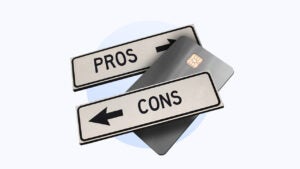Should you sign the back of your credit card?

Key takeaways
- While many credit cards no longer require a signature on the back, it’s still a good practice to sign yours in case a merchant requests it.
- Many cardholders opt for writing “See ID” instead of a signature, but this may not be helpful and can even invalidate your card.
- With advancements in technology, the use of signature verification at the point of sale is becoming outmoded, making signing your credit card less critical.
Many of us are used to manually or electronically signing a receipt for a credit card transaction at the cash register. But one area where your signature may no longer be mandatory is on the back of your credit card, as some card issuers these days don’t require it or even provide an area for a signature. However, many credit cards still mandate that you sign it. So if there is a blank white box on the back, take the time to insert your autograph there. Even though it’s become an outdated practice for many, it can’t hurt to sign the box just in case a merchant checks the back of your card.
Learn more about the practice of signing the back of your card, how technology has changed matters, how to safeguard your account and prevent fraud, and other ways to improve credit card security.
The history of signing credit cards
For decades, many credit cards have included a white signature box on the back of the plastic that the issuer required you to sign for the card to be valid and activated.
Ted Rossman, senior industry analyst for Bankrate, points out that credit card signatures used to be viewed as a fraud deterrent.
“The customer was supposed to sign at the point of sale, and the cashier was supposed to compare that signature with the signature on the back of their card,” Rossman says. “But cashiers rarely asked, and they typically weren’t in a position to accurately judge this sort of thing or detect forgery anyway.”
Indeed, it’s likely been a while since a cashier actually glanced at the back of your credit card. Today, more successful fraud-preventing measures and technology are in place that protect retailers and customers alike.
Is signing your card still required?
If you are issued a new credit card, you may be required to sign it if there is a white signature box on the back. That’s certainly true if the credit card issuer indicates on the card or the letter that came with it that the card is not valid unless it has an authorized signature.
“It’s technically required by many card networks and issuers, even though the vast majority of transactions no longer require a signature at the point of sale,” Rossman says.
Note that some merchants may perceive an unsigned card as inactive and invalid, which could result in a denial of your card. If in doubt, contact your credit card issuer or refer to the fine print in your credit card agreement to learn whether signing your card is mandatory.
Use good judgment when it comes to how you sign your card, thinking of it as a legal document of sorts. Make sure your pen is permanent and, for consistency, use the same signature you would on other official documents.
Don’t worry if you receive a new card without a signature box on the back. My Prime Visa card, for example, doesn’t have an obvious space for a signature. When I called Chase to ask whether to sign the card at all, Chase told me I didn’t need to.
So, if you don’t see the box or any other area where you can sign, and you’re unsure if a signature is needed, you can contact the credit card company to confirm. Chances are, the signature isn’t required.
Should you write “See ID”?
What if you write in the words “See ID” on the back of your card instead of providing your signature? Is that permissible, and can it reduce the risk of someone trying to steal or copy your signature?
The cardholder’s intention here is simple: Keep your signature private — but if the merchant or cashier looks at the back of your card, they will notice the words “See ID” and request your driver’s license or other form of ID. Some merchant agreements prohibit retailers from forcing cardholders to present identification as a condition for completing a sale.
Furthermore, your card could be regarded as invalid and inactive if your credit card issuer requires you to sign your credit card but you write “See ID” instead.
Writing anything other than your signature in the signature box isn’t going to help you, and it could complicate your transaction. Therefore, it’s best to avoid writing “See ID.”
Does signing a card prevent fraud?
Signing the back of your card will likely do little to prevent fraud, because most cashiers and merchants no longer compare the signature on the back of your card to a penned or electronic signature you provide at checkout. That said, it can’t hurt to sign the back of your card if a white signature box on the back exists.
That signature can provide an additional layer of authentication should a merchant request it.
Technology’s role in changing this practice
Today, newer credit cards employ EMV — short for Europay, Mastercard and Visa — chips built into credit cards that use a metallic chip to store cardholder information. Special readers are needed to authenticate these chips, which improves security compared to credit cards that rely only on magnetic stripes.
“Chip-enabled credit cards have become commonplace over the past decade, offering more sophisticated fraud-prevention techniques that have almost entirely replaced the need to swipe a magnetic stripe card and sign your name to complete a transaction,” says Rossman.
Tips for credit card security
Follow these tips to improve security and prevent credit card fraud:
- Select a strong and unique password and PIN that’s different from what you use for other accounts.
- Monitor your statements and transactions regularly online.
- Avoid sharing your card information with others.
- Don’t use credit cards to complete transactions on public computers or public Wi-Fi.
- Be cautious about providing credit card details over the phone or online.
- Enable transaction alerts and two-factor authentication for added security.
- Check your three free credit reports regularly, looking closely for any irregularities that may indicate fraud.
- Shred or destroy closed or old credit cards.
If you are a victim of credit card fraud, sign up for a free or paid credit-monitoring service designed to routinely scan your credit reports for suspicious or fraudulent activity, or any new credit cards opened in your name. “Most of these services will allow subscribers to place a freeze on their credit if necessary so that abusers cannot open new lines of credit without elevated approvals,” says Sean Salter, associate professor of finance at Middle Tennessee State University.
The bottom line
Think you no longer have to apply a pen to that plastic? Don’t assume. When in doubt, check with your credit card issuer to confirm if your signature is a must on the back of your card and where to place that John Hancock.
“I still think it’s a good idea to sign the back of your card,” Rossman advises. “It just takes a few seconds, and there’s no good reason not to.”
Follow best practices for safe card usage and storage and to prevent bad actors from stealing your identity and fraudulently using your card.
You may also like


Will a charge card help my credit?





